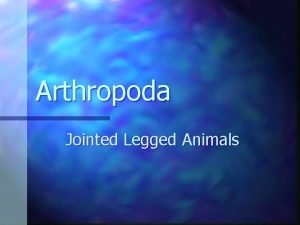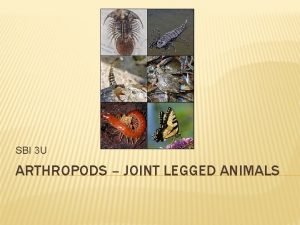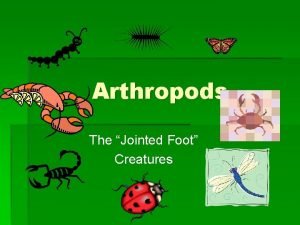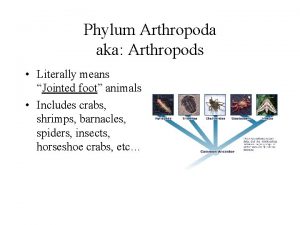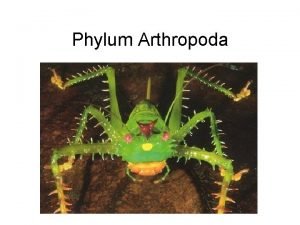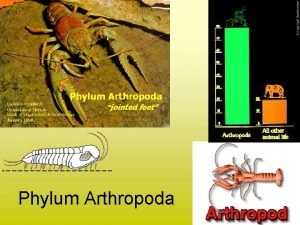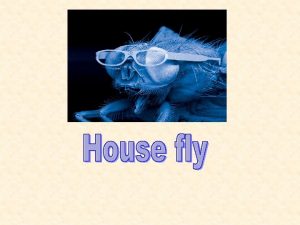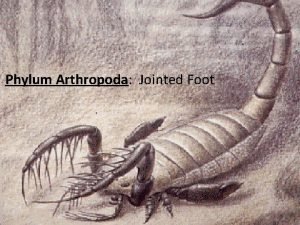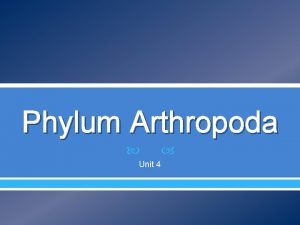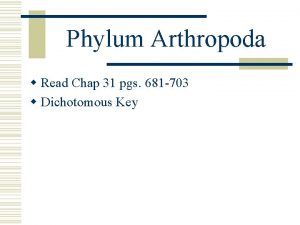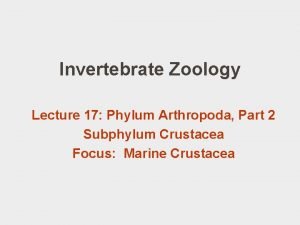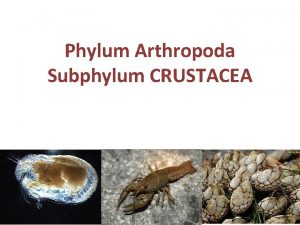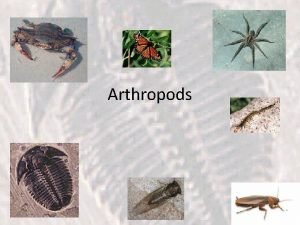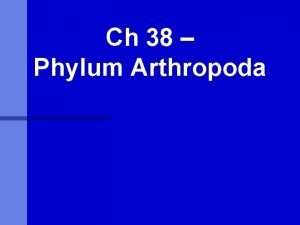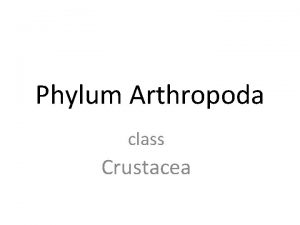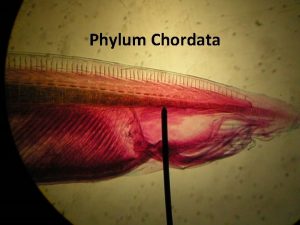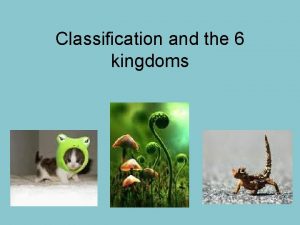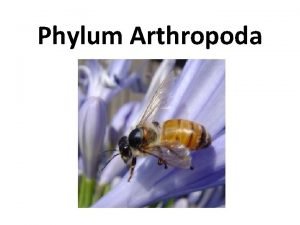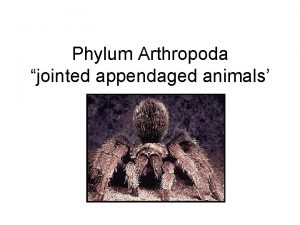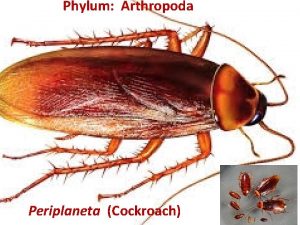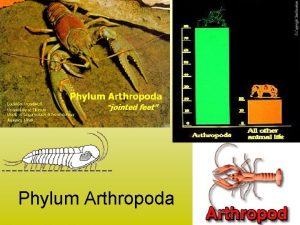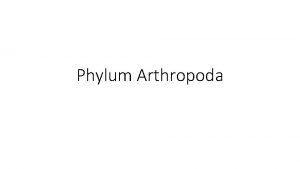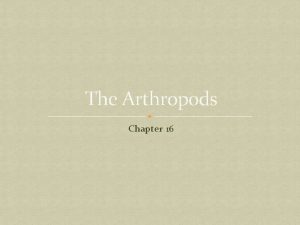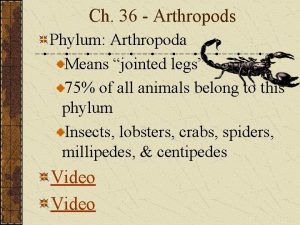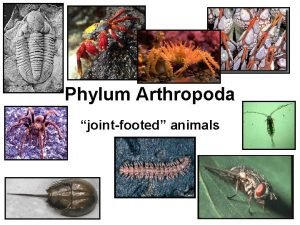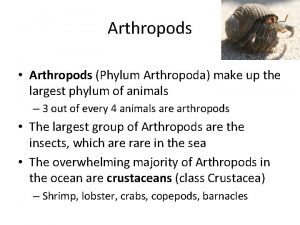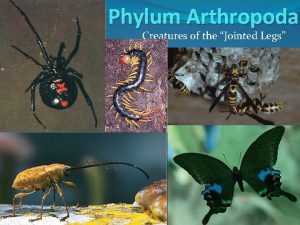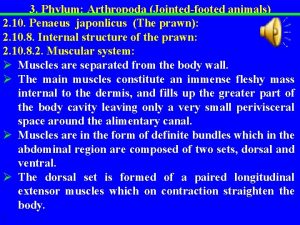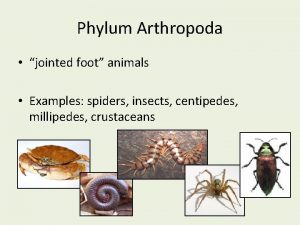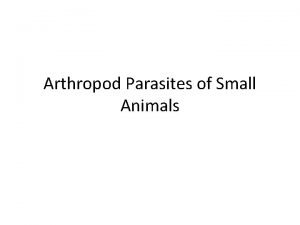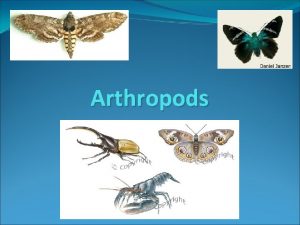Phylum Arthropoda jointed appendaged animals Arthropods Phylum Arthropoda































- Slides: 31

Phylum Arthropoda “jointed appendaged animals’

Arthropods: Phylum Arthropoda • The phylum with the greatest number of species • Four lineages: – Trilobites (all extinct) – Chelicerates (spiders, mites, scorpions) – Crustaceans (crabs, shrimps, barnacles) – Uniramians (insects, centipedes, millipedes)

Adaptations for Success • Hardened exoskeleton • Jointed appendages Do not post on Internet • Fused and modified segments • Respiratory structures • Specialized sensory structures • Division of labor Figure 25. 26 Page 432

Chelicerates • Originated in seas • A few are still marine: horseshoe crabs, sea spiders • The arachnids are all terrestrial Spiders Mites Scorpions Chiggers “Daddy longlegs” Ticks

Subphylum Chelicerata These are the scorpions, spiders, mites, horseshoe crabs, and "sea spiders. " Chelicerates have six pairs of appendages, which are uniramous (unbranched). These include a pair of chelicerae, a pair of pedipalps, and four pairs of walking legs. Chelicerates lack mandibles and antennae. Respiration is by means of book gills, book lungs, or tracheae.

Class Arachnida Arachnids have a pair of tagmata called a prosoma (cephalothorax) and opisthosoma (abdomen). The prosoma is partially or completely covered with a carapace-like shield. The opisthosoma may be segmented or unsegmented. The appendages on the opithosoma are absent or modified, being used as spinnerets (spiders) or pectines (probably sensory in function, found in scorpions). Respiration is via tracheae or book lungs; it is cutaneous in many small arachnids.

house spider Achaearanea tepidariorum

Body Plan of a Spider eye brain heart digestive gland Malpighian tubule poison gland book lung ovary silk gland pedipalp mouth sperm receptacle anus spinners chelicera Figure 25. 28 Page 433

beach wolf spider Arctosa littoralis

Crustaceans • Most are marine, some freshwater, a few terrestrial Copepods • Head has two pairs of antenna, three pairs of food-handling appendages Lobsters Crayfish Barnacles Shrimps Crabs Isopods (pillbugs)

Lobster Body Plan one of two eyes antennae (two pairs) fused segments of cephalothorax segments of abdomen food-handling appendages (three pairs) swimmerets tail fin first leg five walking legs (five pairs total) Figure 25. 29 a Page 434

Subphylum Crustacea (crustaceans) Members of the Subphylum include lobsters, crabs, crayfish, shrimp, copepods, barnacles, and several other groups of organisms. All have two pairs of antennae, a pair of mandibles, a pair of compound eyes (usually on stalks), and two pair of maxillae on their heads, followed by a pair of appendages on each body segment (crustacean bodies usually are made up of head, thorax, and abdomen, although the segments composing these tagmata differ among different Classes). The appendages are primitively branched (biramous), and although this condition is modified in many species, adults always have at least some biramous appendages. Crustaceans respire via gills. Like other arthropods, all have a hard but flexible exoskeleton.

blue crab Callinectes sapidus

Daphnia pulex

rusty crayfish Orconectes rusticus

yellowline arrow crab Stenorhynchus seticornis



Uniramians are arthropods whose appendages are unbranched. Most appendages are made up of several articulating pieces. The uniramian body has two or three tagmata, and the abdomen contains numerous segments. The head appendages include paired antennae and mandibles, and also two pairs of maxillae (the second pair may be fused or sometimes absent). "Breathing" is by means of tracheae and spiracles. The sexes are separate, but most other aspects of reproduction are extremely varied.

Class Insecta (insects) A number of features, however, are shared by most kinds of living insects. In addition to the general characteristics of uniramians, these include a body composed of three tagmata, a head, thorax, and abodmen; a pair of relatively large compound eyes and usually three ocelli located on the head; a pair of antennae, also on the head; mouthparts consisting of a labrum, a pair of mandibles, a pair of maxillae, a labium, and a tonguelike hypopharynx; two pairs of wings, derived from outgrowths of the body wall (unlike any vertebrate wings); and three pairs of walking legs.

Insect Body Plan • Thorax usually has three pairs of legs and one or two pairs of wings • Abdomen contains most internal organs and specialized structure for reproduction • Three-part gut • Malpighian tubules attach to midgut and serve in elimination of wastes

Insect Diversity • The only winged invertebrates • More than 800, 000 known species • Most successful species are small in size and have a great reproductive capacity

yellow fever mosquito Aedes aegypti

black-and-yellow argiope Argiope aurantia redlegged grasshopper Melanoplus femurrubrum

band-winged grasshoppers Oedipodinae


Class Chilopoda (centipedes) Centipedes are uniramian arthropods whose bodies are made up of a chain of many (up to 177) flattened segments, each except the one behind the head and last two bearing a single pair of appendages (legs). The appendages of the first body segment have been modified to form large, poisonous fangs that are used to capture prey. The bite of a large centipede, however, can be painful to an adult and dangerous to a small child.

Millipedes and Centipedes • Segmented bodies with many legs • Millipedes – Two pairs of legs per “segment” – Scavengers • Centipedes – Flattened, with one pair of legs per segment – Predators


Class Diplopoda (millipedes) Like centipedes, millipedes have bodies that are made up of numerous segments. The first four thoracic segments each bear a single pair of legs, but the following abdominal segments all have two pairs. Millipedes lack poisonous fangs and do not bite; rather, to discourage predators they roll into a defensive ball and many emit poisonous or foulsmelling substances.

Narceus americanus
 Arthropods are jointed-legged animals. spiders crabs
Arthropods are jointed-legged animals. spiders crabs Joint legged
Joint legged Arthropods characteristics
Arthropods characteristics Means jointed feet
Means jointed feet What means jointed feet
What means jointed feet Arthropoda
Arthropoda Arthropods structure
Arthropods structure Jointed foot
Jointed foot Segmented and jointed body
Segmented and jointed body Arthropoda
Arthropoda Introduction of phylum arthropoda
Introduction of phylum arthropoda Diptera
Diptera Classes in phylum arthropoda
Classes in phylum arthropoda Arthropoda video
Arthropoda video Dichotomous key
Dichotomous key Kingdom animalia phylum arthropoda
Kingdom animalia phylum arthropoda Pereopods
Pereopods Crustacea phylum
Crustacea phylum Arthro drama
Arthro drama Pearson prentice hall
Pearson prentice hall Section 36-1 review phylum arthropoda
Section 36-1 review phylum arthropoda Arthropods characteristics
Arthropods characteristics Reginald spider crab
Reginald spider crab Https//a-z-animals.com
Https//a-z-animals.com Consumer producer decomposer
Consumer producer decomposer Parasitic food chain
Parasitic food chain Animals that eat both plants and animals
Animals that eat both plants and animals Chordata taxonomy
Chordata taxonomy Playtpuses
Playtpuses Animals in the same phylum
Animals in the same phylum Pseudocoelomate phylum name
Pseudocoelomate phylum name Largest phylum of animals
Largest phylum of animals
